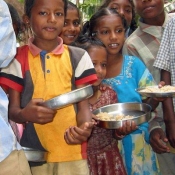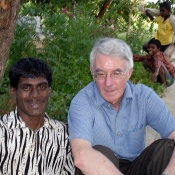It was both a culture shock and a temperature shock to move from the cold of February in Edinburgh to the heat of South India. We had undertaken much planning for our trip – emails back and forth to Dr Chelliah, lots of reading, and long telephone conversations with Kathy – but nothing could have prepared us for the overwhelming warmth of the welcome which engulfed us when we reached the Boys’ Home.
It was quiet when we arrived in the early afternoon as all the boys were away at schools in the neighbouring town. We settled into our comfortable, simple accommodation and then sat outside in the shade of the neem trees. The boys had been told to expect us and as each group came through the gate, hot, dusty and tired, we immediately got a wave and big grins of welcome.
We were invited to be formally introduced to everyone after dinner. In the large hall all the boys were seated on the floor and we sat facing them – a sea of faces gazing up at us. They were as curious about us as we were about them. Johnson, the senior warden, spoke to the boys in Tamil and introduced them to us in age groups, from the tiny little 5 year olds up to the older teenagers, explaining which subjects the older ones were studying. He then pointed out who were brothers.
We were still feeling slightly nervous, not sure what we had let ourselves in for, but then the fun began. Just like at any school in Scotland, the children would entertain their visitors. To our amazement and great pleasure this started with a very lively rendition of Ten Green Bottles! Once the laughter subsided everyone relaxed and this set the tone for the rest of our stay.
Over the next four days Johnson and the staff explained how the Home worked and showed us around the dormitories, kitchens, cowsheds, schoolrooms (including music, hobbies, woodwork, tailoring and computers), the farm work with its cows, chickens, goats and crops. Endlessly patient, they answered all our questions.
Dr Chelliah was very interesting and informative as he discussed some of the particular disabilities of the boys and the difficulties they will face in the future. Part of the Neem Tree Trust funding helps to bridge the gap between the supported environment of the Home and the outside world where a young man will have to earn his own living. This is in line with the Home’s aim of enabling the boys to become self sufficient adults.
Princess (Dr Chelliah’s wife) proved to be an excellent tour guide and travelling companion as she escorted us on some site seeing trips. The highlight was visiting Cape Comorin at the very tip of India to watch the sunset. We even managed to attend an English church service at 7.30am!
There are too many memories of the boys themselves to write about them all – the One Meal Programme children wanting to see their photographs on the camera’s digital display; the amazing, fiercely competitive cricket match; the bus outing to the Science Park; an hour spent studying every photograph in the India guidebook with some of the little ones; the quiet evening conversations with the young men who will leave the Home this year, when they talked of their hopes for the future. None of this was inhibited by language differences.
We were very privileged to see at first hand what a well run and worthy organisation the Boys’ Home is and how donations to the Neem Tree Trust are making a difference to the future of these disabled young people.








